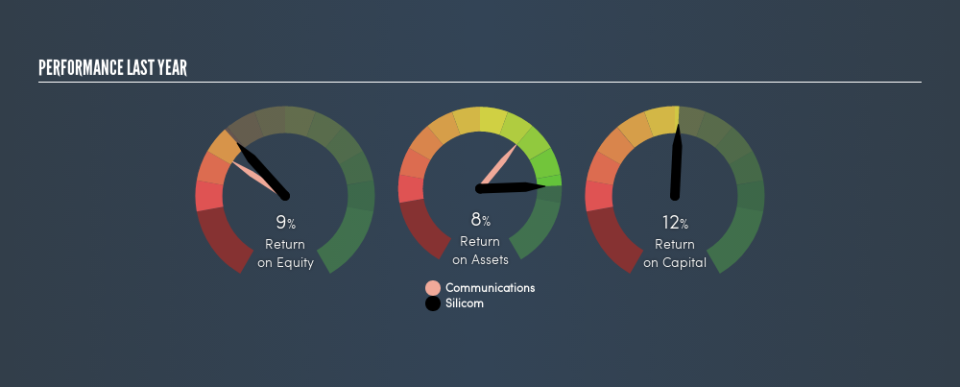Why We Like Silicom Ltd.’s (NASDAQ:SILC) 12% Return On Capital Employed

Today we are going to look at Silicom Ltd. (NASDAQ:SILC) to see whether it might be an attractive investment prospect. Specifically, we’ll consider its Return On Capital Employed (ROCE), since that will give us an insight into how efficiently the business can generate profits from the capital it requires.
First of all, we’ll work out how to calculate ROCE. Second, we’ll look at its ROCE compared to similar companies. And finally, we’ll look at how its current liabilities are impacting its ROCE.
Return On Capital Employed (ROCE): What is it?
ROCE is a metric for evaluating how much pre-tax income (in percentage terms) a company earns on the capital invested in its business. In general, businesses with a higher ROCE are usually better quality. Overall, it is a valuable metric that has its flaws. Renowned investment researcher Michael Mauboussin has suggested that a high ROCE can indicate that ‘one dollar invested in the company generates value of more than one dollar’.
How Do You Calculate Return On Capital Employed?
Analysts use this formula to calculate return on capital employed:
Return on Capital Employed = Earnings Before Interest and Tax (EBIT) ÷ (Total Assets – Current Liabilities)
Or for Silicom:
0.12 = US$20m ÷ (US$183m – US$22m) (Based on the trailing twelve months to December 2018.)
So, Silicom has an ROCE of 12%.
View our latest analysis for Silicom
Is Silicom’s ROCE Good?
When making comparisons between similar businesses, investors may find ROCE useful. In our analysis, Silicom’s ROCE is meaningfully higher than the 7.5% average in the Communications industry. We would consider this a positive, as it suggests it is using capital more effectively than other similar companies. Regardless of where Silicom sits next to its industry, its ROCE in absolute terms appears satisfactory, and this company could be worth a closer look.
Remember that this metric is backwards looking – it shows what has happened in the past, and does not accurately predict the future. ROCE can be deceptive for cyclical businesses, as returns can look incredible in boom times, and terribly low in downturns. ROCE is only a point-in-time measure. Since the future is so important for investors, you should check out our free report on analyst forecasts for Silicom.
Silicom’s Current Liabilities And Their Impact On Its ROCE
Liabilities, such as supplier bills and bank overdrafts, are referred to as current liabilities if they need to be paid within 12 months. Due to the way ROCE is calculated, a high level of current liabilities makes a company look as though it has less capital employed, and thus can (sometimes unfairly) boost the ROCE. To check the impact of this, we calculate if a company has high current liabilities relative to its total assets.
Silicom has total assets of US$183m and current liabilities of US$22m. Therefore its current liabilities are equivalent to approximately 12% of its total assets. Low current liabilities are not boosting the ROCE too much.
The Bottom Line On Silicom’s ROCE
Overall, Silicom has a decent ROCE and could be worthy of further research. Of course you might be able to find a better stock than Silicom. So you may wish to see this free collection of other companies that have grown earnings strongly.
I will like Silicom better if I see some big insider buys. While we wait, check out this free list of growing companies with considerable, recent, insider buying.
We aim to bring you long-term focused research analysis driven by fundamental data. Note that our analysis may not factor in the latest price-sensitive company announcements or qualitative material.
If you spot an error that warrants correction, please contact the editor at editorial-team@simplywallst.com. This article by Simply Wall St is general in nature. It does not constitute a recommendation to buy or sell any stock, and does not take account of your objectives, or your financial situation. Simply Wall St has no position in the stocks mentioned. Thank you for reading.

